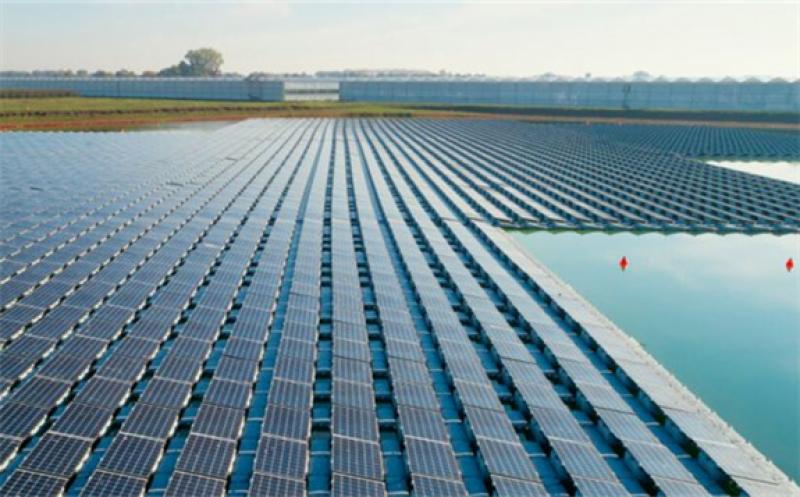DNV, the independent energy expert and assurance provider today publishes the world’s first recommended practice (RP) for floating solar power projects following a collaborative joint industry project (JIP) involving 24 industry participants.

The Recommended Practice (DNVGL-RP-0584) will provide commonly recognized guidance based on a list of technical requirements for accelerating safe, sustainable and sound design, development, operation and decommissioning of floating solar photovoltaic (FPV) projects.
Floating solar power is a promising renewable energy technology in which solar panels are installed on floating structures on the surface of suitable bodies of water. The technology offers great potential for green energy production, particularly in areas where there is a shortage of available land for large photovoltaic plants.
The wider adoption of floating solar power could scale up particularly in countries that have high population density and limited spare land. such as in many Asian nations.
Following the first projects in 2006, installed capacity for floating solar power was just 10 MW by 2015 but has accelerated considerably since then, reaching 2 GW towards the end of 2020. It is estimated that the total global potential capacity for deploying floating solar power on manmade, inland waters alone could be as high as 4 TW with an expected pipeline of more than 10 GW by 2025.
While FPV is a promising growing industry, there are a number of complexities associated with the installation of floating solar plants. The RP offers insight into the technical complexity of designing, building and operating on and in water, especially in terms of electrical safety, anchoring and mooring issues, operation and maintenance, and designing FPV plants that can withstand site-specific environmental conditions.
Ditlev Engel, CEO of Energy Systems at DNV said: “Floating solar is an untapped, fast-growing technology with huge potential and I hope this recommended practice will drive the adoption and scaling of this technology to accelerate the pace of the energy transition. With collaboration from leading companies around the world, it provides critical reassurance to the likes of investors and governments as well as leaders from across the energy industries that we are able to transition faster to a clean energy future and realize the goals as per the Paris agreement.
“With input from both our renewables and floating structures experts, this project perfectly demonstrates the strength and depth of our new Energy Systems business area.”
The JIP, which kicked off last summer, reviewed all aspects of developing floating solar projects on inland and near-shore waters. It focuses on five key topics: site conditions assessment, energy yield forecast, mooring & anchoring systems, floating structures, permitting and environmental impact.
DNV project manager Michele Tagliapietra said: “We created this recommended practice to ensure harmonized and quality approaches in developing floating solar power projects to increase confidence from investors, regulators and other stakeholders. The guidance of this recommended practice aims to increase quality, minimize risks and ultimately increase trust, avoiding failures and accidents which may put a break on the potential growth of this promising market.
“It has been a highly collaborative effort, for which we thank all the participants involved. It is encouraging to see how everyone is striving to increase the quality and reliability of this exciting industry.”
“Being pioneers of this floating solar market, we are delighted to see this JIP team work taking shape in the form of this Recommended Practice. We believe this is a great step towards unlocking the potential of floating solar”, said Olivier Philippart, Director at Ciel & Terre International, one of the 24 participants in the project.
The RP focuses on methodology to keep the RP as technology neutral as possible and provide functional requirements, recommendations and guidelines. It has a holistic system-level approach, including single key components as well as procedures and design considerations and focus on FPV projects in inland and near-shore water bodies.
The Floating Solar JIP consortium features a varied array of companies from across Asia, Europe and North America with extensive experience in the floating solar and related industries.
Members are:
DNV
Acciona Energia
Baywa r.e.
Blue C Engineering
Carpi Tech
Makor Energy Solutions
Ciel & Terre International
CNR (Compagnie National du Rhône)
EDF Électricité de France
EDP Energias de Portugal
Equinor
Innosea part of Aqualis Braemar LOC Group
Isigenere
JLD Contracting
Mainstream Renewable Power
Noria Energy
QuantSolar Technologies
RWE
Scatec
Seaflex
SolarMarine Energy
Statkraft
SunRise E&T Corporation
TNO
Total
About DNV
DNV is the independent expert in risk management and assurance, operating in more than 100 countries. Through its broad experience and deep expertise DNV advances safety and sustainable performance, sets industry benchmarks, and inspires and invents solutions.
Whether assessing a new ship design, optimizing the performance of a wind farm, analyzing sensor data from a gas?pipeline?or certifying a food company’s supply chain, DNV enables its customers and their stakeholders to make critical decisions with confidence.
Driven by its purpose, to safeguard life, property, and the environment, DNV helps tackle the challenges and global transformations facing its customers and the world today and is a trusted voice for many of the world’s most successful and forward-thinking companies.
In the energy industry
DNV provides assurance to the entire energy value chain through its advisory, monitoring, verification, and certification services. As the world’s leading resource of independent energy experts and technical advisors, the assurance provider helps industries and governments to?navigate the many complex, interrelated transitions taking place globally and regionally, in the energy industry. DNV is committed to realizing the goals of the Paris Agreement, and supports customers to transition faster to a deeply decarbonized energy system.